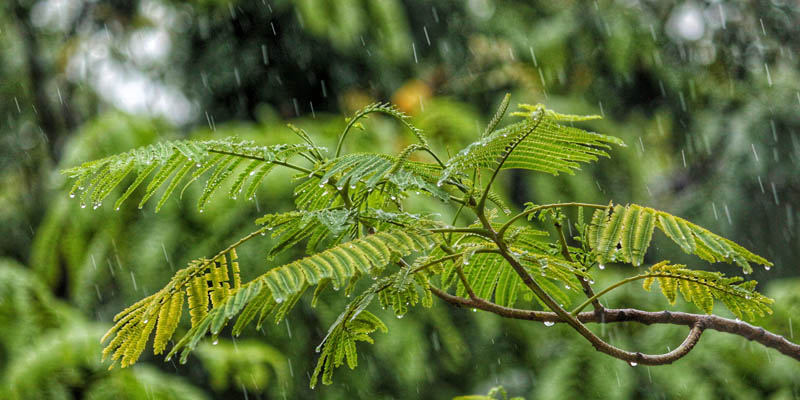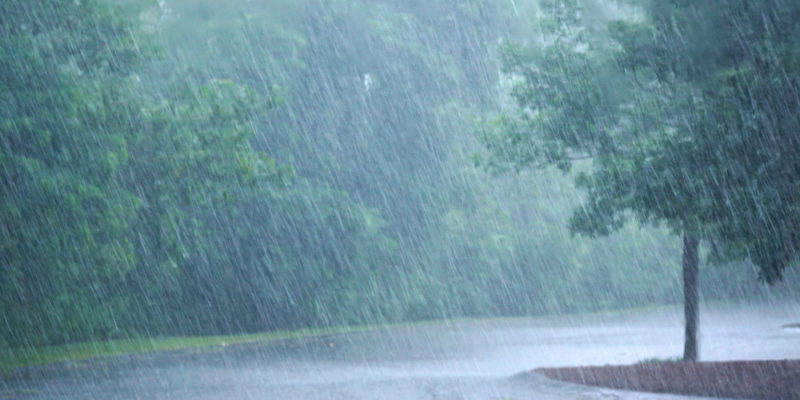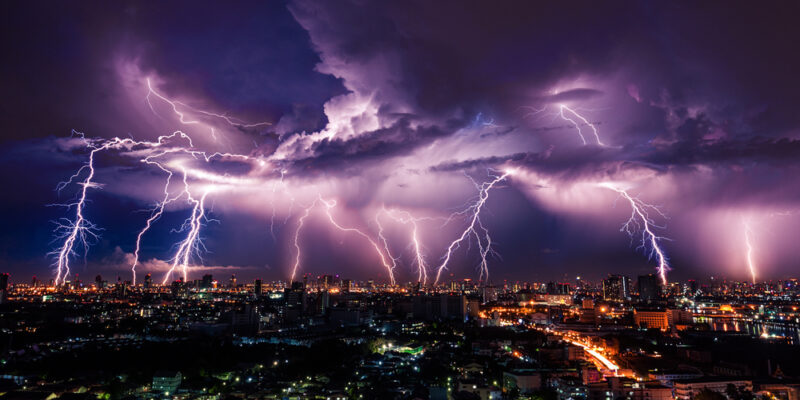We explain what rain is, and discuss how it is formed and measured. In addition, we explore its characteristics, environmental risks, and benefits.

What is rain?
Rain is a common atmospheric and hydrometeorological phenomenon on our planet. It consists of falling liquid water particles in the form of dispersed droplets that result from the condensation and cooling of water vapor in the atmosphere.
Rain occurs daily in different regions of the planet, in some areas being more frequent than in others, both over the sea and land. The formation of rain depends on three specific factors: temperature, atmospheric pressure, and atmospheric humidity.
Rain is a component of the hydrologic or water cycle. By this cycle, the water in oceans, lakes, rivers, and Earth's surface evaporates due to the action of the sun, transforming into water vapor in the atmosphere. When water vapor cools, it condenses returning to the liquid state, and then falls back to the surface in the form of rainfall.
- See also: Water cycle
How is rain formed?
There are three ways in which rain can occur:
- Convective precipitation. It occurs when the sun heats a body of water evaporating it. The water vapor rises into the atmosphere, cools, and condenses. This forms water droplets which, due to the force of gravity, precipitate from the atmosphere to the surface in the form of rainfall. This type of rain mainly occurs in regions near the equator, where the sun's rays are most intense and evaporation is higher.
- Orographic precipitation. It occurs when moist air rises over a mountain slope. As it gains altitude, air cools, condenses, and precipitates in the form of rain. In this way, the mountain slope that receives the incoming moisture-laden air mass usually has a rainy climate, while the other slope receiving air without moisture results in a much drier climate. This type of rain is only found in mountainous areas.
- Cyclonic or frontal precipitation. It is caused by the collision of two air masses with different temperatures. They may be the result of cold or warm fronts, and occur when the cold air in an air mass condenses the moisture in the atmosphere causing precipitation. Cold front rains bring storms of short duration, temperature drop, and heavy rainfall in a short time. Warm front rains cause drizzles that may last for several days and rise in temperature.
How is rainfall measured?

The measurement of rainfall is often expressed in millimeters of precipitation. The device used to measure rainfall is the rain gauge, which is a container that collects rainwater during rainfall and has a measurement scale that displays the amount of rain that has fallen.
Rain gauges are placed in open areas to avoid obstruction by objects such as billboards, trees, or buildings. Weather bureaus charged with measuring rainfall install them at airports, racetracks, stadiums, and other outdoor spaces.
Once rain has stopped, the data from the rain gauges is collected to determine how much rain fell in a given area on a given day. With this information, monthly and annual rainfall data is obtained for a given area.
What does rainwater consist of?
The content of rainwater may vary depending on geographic location, climatic conditions, and other environmental factors, but generally it contains the following components:
- Pure water. Rainwater is primarily pure water (H₂O), although it may contain small amounts of other dissolved chemical elements and compounds.
- Atmospheric gases. Rainwater may contain dissolved atmospheric gases, such as oxygen, nitrogen, carbon dioxide, and nitrogen oxides.
- Suspended solids. Rainwater may also contain suspended solid particles like dust, volcanic ash, pollen, and microorganisms.
- Contaminants. Rainwater in urban and industrial areas may contain pollutants such as heavy metals, volatile organic compounds, and toxic chemicals.
Distribution of rainfall in the world

At the global level, the region with the world’s highest annual rainfall is the Intertropical Convergence Zone, which lies near the equator. It is a warm, rainy area located between the Tropic of Cancer in the Northern Hemisphere and the Tropic of Capricorn in the Southern Hemisphere.
In temperate climate regions, precipitation is highly variable. Extremely dry regions such as the Sahara desert, as well as rainy areas like Madagascar forests can be found. The distribution of rainfall at these latitudes is influenced by humidity, wind systems, and the distribution of mountainous relief.
In polar and subpolar regions, rainfall is infrequent due to the dry, low-temperature air at the poles.
Types of rain

Depending on the intensity, rainfall can be classified into:
- Drizzle. It is very light rain consisting of small droplets, with extremely low rates of accumulation that may go undetected.
- Shower. It is rain of medium to high intensity, usually of short duration and accompanied by wind.
- Downpour. It is torrential rain of medium duration with extremely high rates of accumulation on the surface.
- Thunderstorm. It is rain of high intensity accompanied by intense winds and electrical activity. It may also be accompanied by hail, lightning, and thunder.
What are the environmental benefits of rain?
Rain provides important environmental benefits for the planet:
- It supplies fresh water that feeds rivers, aquifers, lakes and ponds, and provides drinking water to human populations.
- It maintains the biodiversity of terrestrial and aquatic ecosystems, which helps sustain plant and animal life cycles. Moreover, it is essential for food production.
- It enables the balance of atmospheric temperatures as well as salinity and temperature levels in ocean water.
- It transports nutrients and sediments that help maintain water quality and control erosion.
Water-related issues
Water is one of the most important natural resources on the planet. Its availability and quality may be affected by various environmental issues, including:
- Water pollution. Water pollution can be caused by discharges of industrial waste, pesticides and fertilizers, and human and animal waste. This may affect water quality and pose risks to human health and biodiversity.
- Water scarcity. Water scarcity is a serious problem affecting many regions in the world, especially arid and semi-arid areas. Overexploitation of water resources, urban development, and climate change are among the factors contributing to this problem.
- Floods. Floods are a growing problem that impact more and more people every day. The increase in rainfall as a consequence of climate change, the impermeabilization of soils due to human activity, and the expansion of cities without adequate urban planning are some of the causes that contribute to worsening this issue.
Other forms of precipitation

In addition to rainfall (liquid water), other forms of precipitation are:
- Snow. When atmospheric temperature is sufficiently low, water falls in a semi-solid state. This type of rain is called "snow".
- Hail. When raindrops form at high altitudes, their temperature is very low and they freeze. If their temperature does not rise enough to melt before reaching the ground, they fall in the form of small lumps of ice known as "hail".
Origin of rain
Two contending theories account for the origin of water on planet Earth:
- Volcanic origin theory. According to this theory, water originated within Earth’s interior and was subsequently expelled into the atmosphere by volcanic activity.
- Extraplanetary origin theory. This theory proposes that water arrived on our planet via ice-rich meteorites and comets. Upon reaching Earth, this ice might have melted giving rise to liquid water on the planet.
Nevertheless, part of the scientific community holds that water might have appeared on the planet as a combination of both theories.
Explore next:
References
- Nasa Climate Change (s.f). El ciclo del agua. Nasa
- Goudie, A. (1993). La naturaleza del ambiente. Cap. 2. Funcionamiento de la climatología global. Progreso en Geografía Física.
- González, A (s.f). Tipos de lluvias. MagicaNaturaleza
Was this information useful to you?
Yes NoThank you for visiting us :)